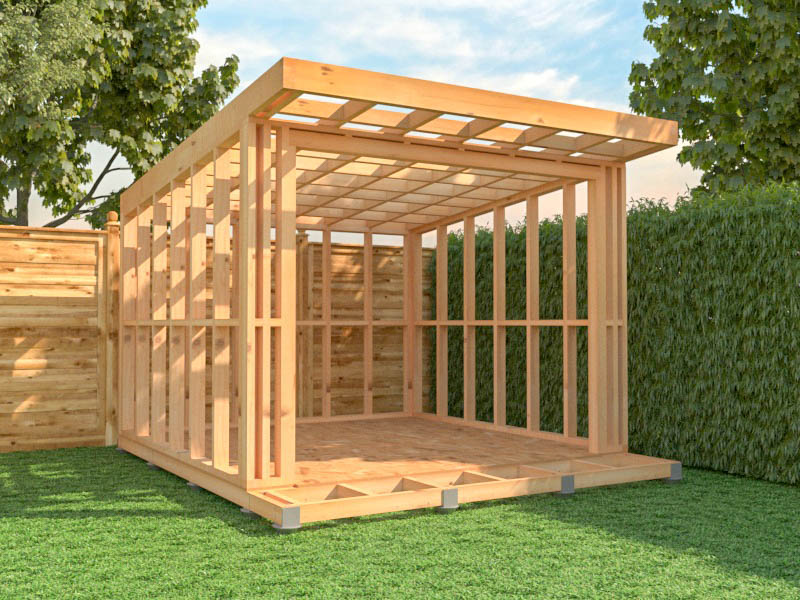Wall Structures
There are several different structural systems used in garden office construction - from traditional building methods of creating a skeleton of timbers to high tech engineered panel systems.
The quality of the garden office structure can vary from supplier to supplier; some firms adopt a system that creates the thinnest of structures which are quick and cost-effective to build, while other companies create a framework which is akin to that used in modern housebuilding.
In this guide, we'll walk you through the popular core structures systems used in garden office design, they include:
- Traditional Timber Frame
- Structural Insulated Panels
- Hybrid SIPs
- Steel Frames
- Post and Beam Frames
- Interlocking Timbers
- CNC cut skeletons
Traditional Timber Frames
Traditional style timber frames are widely used in garden office design. Although you should be careful when comparing them as the quality varies considerably throughout the market. The basic premise is that the floor, walls and roof are made up of frames, comprising of horizontal timbers at the top and bottom of the frame and vertical timbers in-between. The strength of these frames is determined by the dimension of the timbers and the gaps between them - the closer the timbers are together, the stronger the frame.

These frames are joined together to create the skeleton of the garden office. In quality, garden office builds the frames usually are strengthened further by the addition of a timber sheathing on the exterior of the frame. This sheathing is made from a structural board, such as exterior grade plywood or OSB (orientated strand board) and helps prevent the frame from 'racking', a twisting of the frame which can reduce its strength.
Traditional timber frames, which is sometimes known as stick framing, is very versatile, allowing you flexibility in the positioning of openings. It comes into its own when creating unusual shape garden offices as the frame is made specifically for the site.
In most cases, the frames are built off-site in factory controlled conditions and delivered in panels (sometimes called cassettes) ready for quick assembly. The manageable size of the panels allows them to be used on sites where the access is difficult - they can even be manoeuvred through your house into the garden, if need be.
While the frames of 90% of garden offices are built off-site in factory conditions; a number of suppliers do construct their timber frames from scratch on site. They have all the lengths of timber delivered to the customer's address and cut and frame the building by hand. Whilst this method extends the on-site period considerably, it is particularly useful on difficult sites or one-off builds where every element needs to be measured and cut to order.
One of the key benefits of a traditional timber frame is that its form creates a valuable space for insulation. We'll talk about garden office insulation in more detail in another article, but basically, the insulation, whether it's a fibre mat or a rigid board fits snuggly between the framework. Care and consideration need to be taken at the corners of the frame, and where panels of the frame are joined. To ensure that insulation is present in these areas. Otherwise, areas known as cold spots can occur. These are weak points in the structure that can leak warm air out of the room.
As we mentioned at the beginning of this section traditional timber frames used for garden offices, come in varying qualities. We have seen examples that are very sturdy, built just like a house and others which are more like a matchstick house! Okay, we exaggerate, but what we are getting at is that frames differ from supplier to supplier, and it's not always evident from a suppliers photograph of a garden office. It would be good practice to ask the suppliers what size timbers are used in their frames. A good sturdy frame can be created with 100mm x 50mm timbers, thicker timbers such as 150mm x 50mm are often used on higher spec designs. Narrower timbers such as 75mm x 50mm are popular and keep the wall structure narrow, meaning more space inside the office, but you wouldn't want to go narrower than that.
Structural Insulated Panels
Structural Insulated Panels known as SIP's have revolutionised the garden office industry because they are cost-effective, quick to install and create a highly insulated building because the insulation isn't broken by structural timbers.
Like other garden office structures, SIP's come in varying qualities, and you should question suppliers who list SIP's on their specifications as to what their make-up is. Ensure that you ensure you are comparing like with like.
SIP's owe their origin from housebuilding, and a number of high spec garden offices are built using SIP's brought from suppliers who also make the panels for houses. These panels are a sandwich of two layers of structural board, normally OSB (Orientated Strand Board) which are filled, under high pressure, with a rigid insulation. This type of SIP is manufactured in factory conditions. The designer sends the plans for the garden office, and the panels are cut to size, and any openings are precision cut.
Some suppliers have taken the concept of the structurally insulated panel in-house and created their own make-up. They take layers of sheet material and a rigid insulation sheet such as Celotex and sandwich them together. This system can create quite a narrow wall section, and the assembly is rapid.
Hybrid SIPS
While the SIP's we have described above are used to create the frame of the building, and you would expect cladding fixed to the outside and a decorative lining inside. We are seeing a growing trend in budget garden office design for hybrid SIP construction which forms not only the structure of the building, but also the external and internal wall finishes. New products have been introduced recently that not only have structural strength but a decorative finish, so can be used as the external leaf. The rigid insulation sheet is laminated to this board, and then another board such as MDF or a board with a vinyl finish forms the interior lining.
We'll talk in detail about how to measure insulation performance in another section of this guide, but the thickness of a SIP is not always indicative of its performance, i.e. a thicker wall is not always better insulated than a thin one, its all down to the composition of the wall and the performance of the materials used. Your way to judge is to compare the u-value of the SIP, the lower the figure, the better performing, a good garden office supplier will be able to tell you the u-value for their SIP's so that you can compare different make-ups.
Timber and composite sheets are commonly used to create the faces of these SIPS. There are, however, a few companies who use a steel insulated panel. They use colour coated steel panels on both sides which offer strength and durability, requiring very little maintenance going forward.
Steel Frames
As garden offices have got bigger, and the shapes become more elaborate, the use of steel has become more prevalent. Steelwork is often used in conjunction with traditional timber frames and structural insulated panel systems, the steel offering great strength and the ability to create bigger buildings and elaborate designs.
We have seen steel used in several different ways in garden office design. Some suppliers use steel columns in the four corners of the building and run steel horizontals between them; this allows the designer to infill the space with different panels such as lightweight SIP's or large expanses of glazing. Because the steelwork is spreading the weight.
Steelwork is the key element in some of the more elaborate shaped garden offices such as those with curved walls where the wall and roof seem to run into each other. Some garden office designers have become very creative with the use of steel, and use it to create some cutting-edge design features such as roofs which appear to float, unsupported.
Post and Beam Structures
Perhaps we should call this a traditional timber frame system. Because post and beam structures have been around for centuries. Strong frames made of two uprights connected to a horizontal beam with traditional joints are spaced along the building to create a sturdy framework into which panels, whether they are insulated panels or glazing or doors can be fitted. The post and beam method is used by a small number of high-end garden office suppliers and offers a great deal of flexibility over the shape and size of the building that can be created.
Interlocking Timbers
Interlocking timbers are used widely in the creation of log cabin style garden offices, and like other structural methods described vary greatly between suppliers. The buildings are constructed by stacking together lengths of timber; each piece has tongues which fit into grooves on the next piece, this creates a large surface area of connected timber.
These interlocking timber systems come in varying qualities; common thicknesses are 28mm and 45mm. The thicker the timber, the more substantial the structure. In most cases, this timber framework forms both the structure of the building, as well as both the external and internal lining of the building (some higher specification systems offer a second leaf to allow insulation to be included in the building).
CNC cut interlocking frame
Several garden office companies are adopting the use of precision, computer-aided technology. This allows them to create shapes of office that would otherwise be difficult to create using normal construction methods, such as curves and eclipses.
Because the computer-aided machinery can cut complex joints with ease, a robust framework can be created from relatively thin materials. Often, structural boards like 18mm thick plywood are used to create the frame. Which then slots together like a giant jigsaw puzzle. This technology allows designers to think outside the box!

